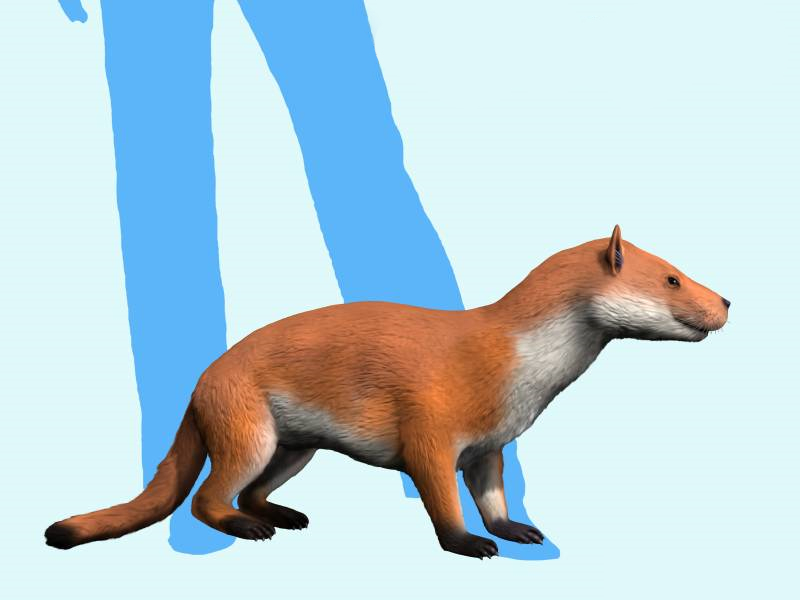Cladosictis NT on:
[Wikipedia]
[Google]
[Amazon]
''Cladosictis'' (meaning "branch weasel") is an extinct genus of
at
 ''Cladosictis'' was a
''Cladosictis'' was a
South America
South America is a continent entirely in the Western Hemisphere and mostly in the Southern Hemisphere, with a considerably smaller portion in the Northern Hemisphere. It can also be described as the southern Subregion#Americas, subregion o ...
n metatheria
Metatheria is a mammalian clade that includes all mammals more closely related to marsupials than to placentals. First proposed by Thomas Henry Huxley in 1880, it is a more inclusive group than the marsupials; it contains all marsupials as wel ...
n from Patagonia
Patagonia () is a geographical region that includes parts of Argentina and Chile at the southern end of South America. The region includes the southern section of the Andes mountain chain with lakes, fjords, temperate rainforests, and glaciers ...
, Argentina
Argentina, officially the Argentine Republic, is a country in the southern half of South America. It covers an area of , making it the List of South American countries by area, second-largest country in South America after Brazil, the fourt ...
( Chichinales, Cerro Bandera
The Cerro Bandera is a hill located on Navarino Island, is visible from Puerto Williams and its top is a flag of Chile, takes about 3 hours to travel back and forth. It is also the first stop to continue the circuit ''Dientes de Navarino''.
Se ...
, Sarmiento Sarmiento may refer to:
Places Argentina
*Sarmiento Department, San Juan, a subdivision of the San Juan Province
* Sarmiento Department, Santiago del Estero, a subdivision of the Santiago del Estero Province
* Sarmiento Department, Chubut, a subdi ...
and Santa Cruz Formation
The Santa Cruz Formation is a geological formation in the Magallanes Basin, Magallanes/Austral Basin in southern Patagonia in Argentina and adjacent areas of Chile. It dates to the late Early Miocene epoch, and is contemporaneous with the eponym ...
s) and Chile
Chile, officially the Republic of Chile, is a country in western South America. It is the southernmost country in the world and the closest to Antarctica, stretching along a narrow strip of land between the Andes, Andes Mountains and the Paci ...
( Río Frias Formation).''Cladosictis''at
Fossilworks
Fossilworks was a portal which provides query, download, and analysis tools to facilitate access to the Paleobiology Database, a large relational database assembled by hundreds of paleontologists from around the world.
History
Fossilworks was cr ...
.org
Description
 ''Cladosictis'' was a
''Cladosictis'' was a fox
Foxes are small-to-medium-sized omnivorous mammals belonging to several genera of the family Canidae. They have a flattened skull; upright, triangular ears; a pointed, slightly upturned snout; and a long, bushy tail ("brush").
Twelve species ...
-like creature that was around long. ''Cladosictis'' probably hunted for eggs and small animals in the low undergrowth, using its low posture for cover. With sharp canines and slicing carnassial
Carnassials are paired upper and lower teeth modified in such a way as to allow enlarged and often self-sharpening edges to pass by each other in a shearing manner. This adaptation is found in carnivorans, where the carnassials are the modified f ...
s, ''Cladosictiss teeth
A tooth (: teeth) is a hard, calcified structure found in the jaws (or mouths) of many vertebrates and used to break down food. Some animals, particularly carnivores and omnivores, also use teeth to help with capturing or wounding prey, tear ...
were similar to those of carnivora
Carnivora ( ) is an order of placental mammals specialized primarily in eating flesh, whose members are formally referred to as carnivorans. The order Carnivora is the sixth largest order of mammals, comprising at least 279 species. Carnivor ...
ns, although the groups were unrelated.
References
External links
* Sparassodonta Miocene mammals of South America Colhuehuapian Santacrucian Friasian Neogene Argentina Fossils of Argentina Neogene Chile Fossils of Chile Fossil taxa described in 1887 Taxa named by Florentino Ameghino Prehistoric mammal genera Neuquén Basin Cerro Bandera Formation Chichinales Formation Golfo San Jorge Basin Sarmiento Formation Austral or Magallanes Basin Santa Cruz Formation {{paleo-marsupial-stub